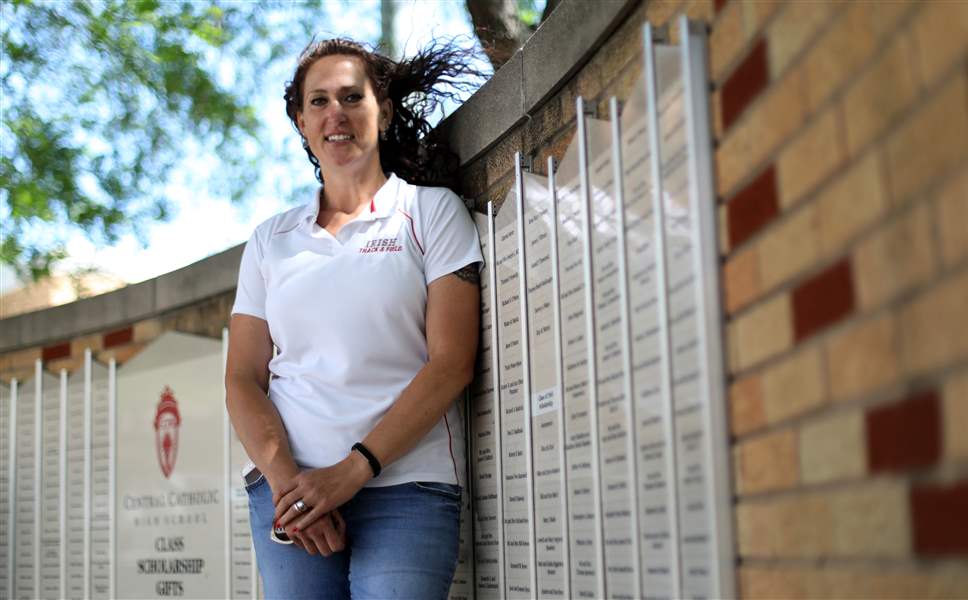
Central Catholic coach reflects on saving life at track meet
6/4/2018
Angie Knannlein-Rahman, the Central Catholic High School throw coach and a Mercy Health St. Charles Hospital ICU nurse, stands in the athletic complex on June 4, 2018. Knannlein-Rahman helped save a Northwestern High School student’s life during the regional track competition in Piqua.
The Blade/Amy E. Voigt
Buy This Image
As she tried to bring junior Adam Riedinger back to life, Angie Knannlein-Rahman was hyperaware of the shadow his mother cast over the scene.
“I was thinking, ‘I’m not going to let these parents watch their son die on the cement today,’” said Ms. Knannlein-Rahman, who is the Central Catholic High School throw coach and a Mercy Health St. Charles Hospital ICU nurse.
WATCH: Angie Knannlein-Rahman describes rescue
She led efforts to aid Adam, a champion thrower at Northwestern High in Springfield, Ohio, as he suffered from cardiac arrest at a regional meet in Piqua on May 26. Along with another nurse and a nurse practitioner, she performed chest compressions and used a portable defibrillator to resuscitate the teen, who was not breathing.
Despite the incident, which occurred before his third throw, Adam, 17, placed first in shot put on Saturday. He won discus the day before.
This past weekend, at the Track and Field State Championship in Columbus, Ms. Knannlein-Rahman, Adam, and Adam’s parents were reunited.
“It was awesome to see her and hug her and thank her for saving me,” Adam said.
He was glad to be able to put a face to the name of the woman who saved his life.
Though the rescue took a matter of minutes, it felt like forever, Ms. Knannlein-Rahman said. Just as an ambulance arrived, Adam woke to the feeling of someone beating his chest.
“I kind of felt like I was in a dream,” he said.
He inhaled, but Ms. Knannlein-Rahman was still holding her breath.
“I didn’t know why his heart stopped, so I didn’t have confidence when they loaded him up that he would make it,” she said.
As the ambulance pulled away, Ms. Knannlein-Rahman ran through possible causes, including heart defects, which could require high-risk surgery. She had seen countless stopped hearts over her 21 years working at St. Charles, but this time felt different. He was only 17, and strong — at regionals, “he was the kid to beat,” she said.
Though the doctors found no heart defects, disappointment mixed with relief when Adam was told of his new limitations. No longer able to play contact sports, Adam will lose the football scholarships he likely would have received from colleges in the coming months. His new goal is to secure a track scholarship, he said.
Still, his prevailing feeling is gratitude.
“If I’d been at home, I wouldn’t have survived, so it’s good that it happened there,” he said. “Very thankful for that.”
The location was far from ideal for the nurses trying to save Adam’s life, though. Accustomed to the highly controlled environment of an emergency room, Ms. Knannlein-Rahman said performing chest compressions, using the defibrillator, communicating with her fellow nurses, and checking the student’s heart rate posed new challenges.
“Out on the cement, it didn’t feel under control at all,” she said. “It was amazing to improvise like that.”
A few days later, doctors implanted a cardioverter defibrillator in Adam’s chest. Ms. Knannlein-Rahman said meeting up with the family at last weekend’s meet was emotional. It reminded her of the reason why she became a nurse: to never watch someone die and be helpless to stop it.
At 16, she looked on, powerless, as a friend died on the pavement just outside her school. Then a student at Central Catholic, Ms. Knannlein-Rahman was jogging with her volleyball team when one of her teammates collapsed. Ms. Knannlein-Rahman held her friend in her arms and tried to wake her up, unavailingly, until the coach and emergency personnel arrived. Her teammate was brain-dead when she started breathing again, and she died days later.
At that time, Ms. Knannlein-Rahman said, “I didn’t know anything.”
Back at Central and telling the story of her recent rescue near the place where her teammate died almost 30 years ago, Ms. Knannlein-Rahman said it seemed like coming full circle.
Contact Lily Moore-Eissenberg at lillianme@theblade.com, 419-724-6368, or on Twitter @LilyM_E